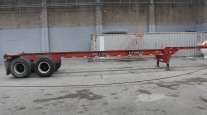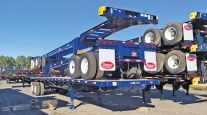Chassis Rule Hits Snags as Implementation Begins
This story appears in the July 12 print edition of Transport Topics.
Implementation of new intermodal chassis safety rules got off to a rocky start on June 30 because of electronic filing failures, but industry officials said they hope an agreement between two trade groups will make the process easier for truckers and other industry participants.
Many reports by carriers and trade group officials on June 30 told of truckers pulling up to terminals and being unable to submit a document called a driver vehicle inspection report. That document is supposed to tell chassis providers what repairs are needed so the equipment is safe to haul.
However, two days later, the Intermodal Association of North America and the Ocean Carrier Equipment Management Association said they agreed to develop electronic connections between their separate DVIR systems, making them compatible to ensure the information was submitted and processed properly.
“Neither one of them work well,” said Chris Giltz, senior vice president of the Evans Group of Cos., which operates at 100 intermodal facilities with a fleet of 1,500 drayage trucks. “We are finding that we can enter DVIRs into one system and the other rejects them.”
“It doesn’t appear that the systems are tied into the facilities at all,” he added, saying operations were smoother at rail facilities where DVIRs were being collected automatically.
“The fact that the systems are completely unready is actually a boon to us because otherwise we would have had drivers stuck at gates all over the country,” Giltz said.
OCEMA has estimated that more than 100,000 chassis moves through terminal gates every day.
The implementation of Federal Motor Carrier Safety Administration rules had been delayed by six months to give intermodal operators time to create a workable data system. Truckers have been pushing for chassis safety rules since 1997, arguing that equipment owners should be responsible for providing safe equipment.
“It has been a confusing start, but there has been a lot of effort to make a seamless connection between the IANA and OCEMA systems,” said David Manning, president of drayage carrier Tennessee Express, Nashville, Tenn.
“That has finally taken place,” said Manning, who leads American Trucking Associations’ Intermodal Motor Carriers Conference. It is going to take some weeks for everyone to understand what they need to do within their company to comply.”
“It didn’t surprise me that there were some matchup problems at the outset,” said Curtis Whalen, executive director of ATA’s Intermodal Motor Carriers Conference, adding that the freight was still flowing smoothly. “A lot of terminal operators and gate operators didn’t realize there were supposed to be changes.”
The South Carolina Trucking Association on July 7 told members that a Maersk Line terminal in the state was asking for a 30-minute delay in filing DVIR reports to allow more time for electronic processing.
One week earlier, the same group advised on implementation day that “terminal/gate operators are not universally informed on the processes that are being set up to receive DVIRs and remove defective chassis at in-gate for repair.”
“While we remain confident that the new regulations will serve to improve both chassis safety and equipment interchange efficiencies . . . we are going to have to endure and work through the confusion that is descending on us today,” the trucking group’s message said.
“The motor carriers are ready; what we had hoped for is that we’d have a standardized system that people could be trained on,” Tennessee Express’ Manning said. “There was a lot of confusion up until the last minute.”
Mark Mayhew, vice president of OCEMA contractor Advent, said on July 7 that the EDI connections between the systems still were being established and should be done within seven days.
“Information technology issues were the primary reason impacting initial interconnectivity of systems,” said Joni Casey, president of IANA. “These have since been resolved.”
She also noted that some chassis providers didn’t register their equipment in IANA’s data system until the day before implementation began, or later in some cases.
Jeffrey Lawrence, executive director of OCEMA, told Transport Topics that same day there were no current reports of problems because the two groups worked together on their data collection systems to make them interact with each other.
The systems can be used by motor carriers, intermodal equipment providers, facility operators, and maintenance and repair vendors, the two trade groups’ joint statement said.
OCEMA’s system accepts information by personal computer or “smart phone.” IANA offers those options, as well as electronic data interchange and other electronic formats.




